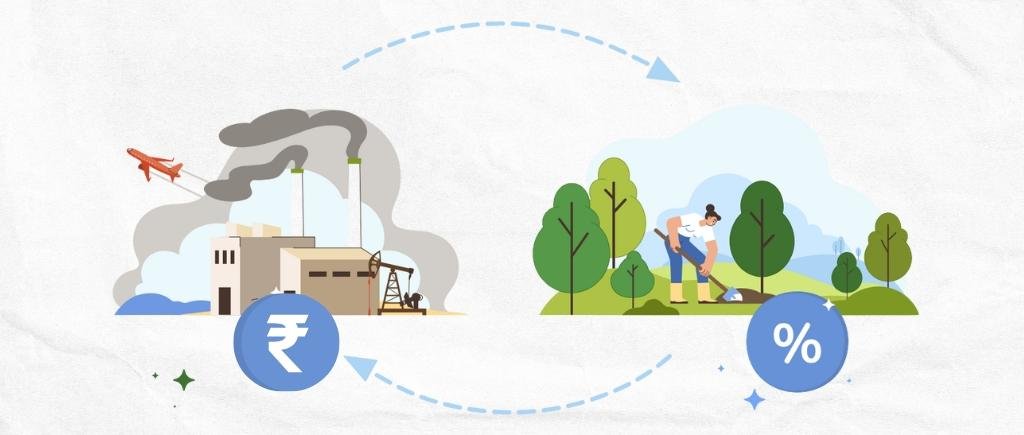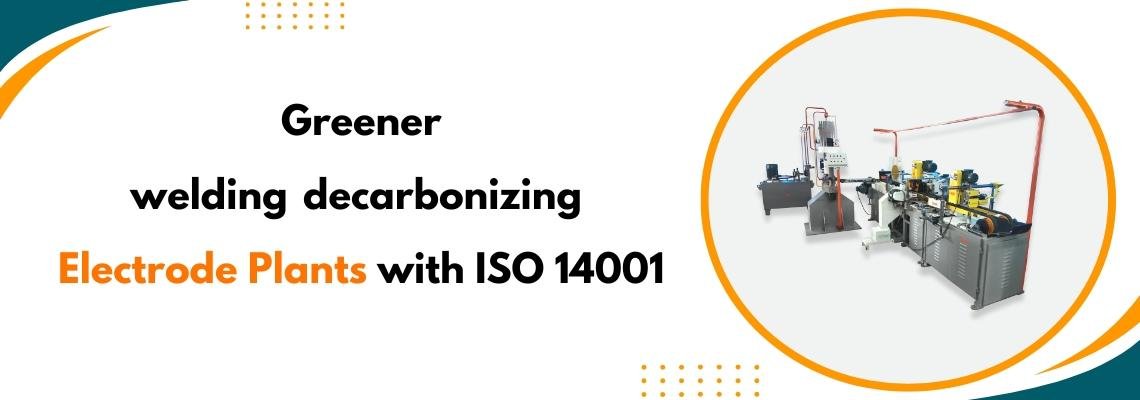Decarbonizing heavy industry is urgent: manufacturing drives roughly 20% of global CO₂ emissions. Electrode plants – which make welding consumables like rods, wires, and graphite electrodes – are energy-intensive and often rely on fossil fuels for heat and power. Shrinking their carbon footprint is both a regulatory necessity and a market opportunity. Cementing an Environmental Management System (EMS) under ISO 14001 gives plant owners a proven framework to measure, manage and reduce emissions systematically. In practical terms, this means auditing energy use, setting clear CO₂ reduction targets, and implementing cleaner processes – all under ISO 14001’s Plan-Do-Check-Act cycle.
Why Decarbonize Electrode Plants?
Electrode production often involves high-temperature processes (e.g. baking cathodes, sintering electrodes, mixing and drying), which typically burn natural gas or coal. For example, a carbon-footprint study of a welding-electrode manufacturer found that over 50% of its CO₂eq emissions came from natural gas used for heating. In other words, small efficiency gains or fuel switches can yield big emission cuts. Moreover, the wider steel and construction sectors increasingly demand “green” inputs. As steelmakers shift to electric-arc furnaces (EAF) to lower their own footprint, they will prefer low-carbon electrodes. In one case, a major graphite-electrode maker reported emissions intensities around 2.0–2.5 tons CO₂ per ton of electrode produceds. Cutting even a fraction of that by adopting renewables or efficiency is both an environmental win and a competitive edge.
Regulators and investors are also tightening requirements. Initiatives like the EU’s Carbon Border Adjustment Mechanism and Scope 3 supply-chain disclosure rules mean electrode manufacturers must report emissions in detail. ISO 14001 certification signals that a plant not only complies with environmental laws but also continually improves performance. In fact, industry leaders tie ISO 14001 directly to their climate goals. Hyundai Welding, for instance, explicitly states it is “reducing its carbon dioxide emissions” and “actively renewing our ISO 14001 (Environmental Management) certification as a proactive measure” toward carbon neutrality.
ISO 14001: A Framework for Sustainability
ISO 14001 is the international standard for environmental management systems. It doesn’t prescribe specific technologies; instead, it requires a structured approach. Organizations must identify environmental risks and impacts, set reduction targets, implement controls, and monitor results. Key ISO 14001 benefits include:
- Systematic Carbon Tracking: Companies commit to measuring all significant emissions. For an electrode plant, this means creating a greenhouse-gas inventory (Scope 1 direct emissions from fuels and process, Scope 2 indirect from electricity). The HEG Limited case (a large graphite electrode maker) shows how ISO-aligned policy drives this: “Our Environment Management Policy, in line with ISO 14001, directs our operations to … minimize our environmental footprint”.
- Energy and Resource Efficiency: ISO 14001 pushes continuous improvement. Plants will identify high-energy processes and waste streams. For example, they might replace old furnaces with better-insulated models, improve process control, or recover waste heat. The standard even encourages adopting complementary norms like ISO 50001 (Energy Management) for deeper cuts. In practice, targets are set and progress tracked, a cycle illustrated by PECB: first assess current emissions, then set reduction goals, and implement energy-saving measures.
- Stakeholder Engagement: Implementing ISO 14001 involves employees, suppliers, and sometimes customers. By auditing the supply chain (Scope 3 emissions), a plant can engage raw-material vendors to source recycled or lower-carbon inputs. As one sustainability report notes, ISO 14001 “requires organizations to engage and collaborate with their stakeholders,” often uncovering new improvement ideas.
- Regulatory Compliance and Reputation: ISO 14001 certification often simplifies legal compliance and helps meet reporting standards. It also signals to customers (like automotive or infrastructure firms) that the plant is committed to sustainability. The PECB guide lists these as direct benefits: “Shows commitment to environmental improvement… increases reputation… contributes to achieving net zero”.
Key Decarbonization Strategies
Under the ISO 14001 framework, electrode plant owners can pursue multiple practical strategies. Below are several high-impact measures:
- Energy Efficiency Upgrades: Conduct an energy audit to pinpoint major uses of fuel and electricity. Upgrading to high-efficiency motors, switching to LED lighting, improving insulation of ovens and boilers, and maintaining equipment can cut waste. For instance, the case study plant cut emissions by focusing on its furnace gas usage. Even small efficiency gains can multiply across shifts and product output.
- Fuel Switching: Reduce Scope 1 fossil fuel use by adopting lower-carbon alternatives. Some options include biofuels or biomass (e.g. wood pellets instead of natural gas in boilers) and electrification (using electric induction or resistance heating in place of gas burners). As Normative’s guidance highlights, replacing on-site fossil fuel with “low/no carbon energy sources like biomass, recovered heating, heat pumps, and electric heating” significantly lowers emissions. More advanced options include blending hydrogen with natural gas or using waste-derived syngas from recycling processes, where feasible.
- Renewable Electricity: For Scope 2 emissions, source green power. This can mean purchasing Renewable Energy Certificates (RECs) or, better yet, installing on-site renewables. The industry example of HEG shows this approach: it “implemented a 3 MW solar PV rooftop system to reduce operational emissions” and plans additional solar, while also leveraging an on-site hydro plant. Similarly, a plant might enter group-captive renewables or PPAs for wind power. Shifting electricity to renewables immediately cuts indirect emissions and future-proofs against carbon taxes.
- Process Improvements and Recycling: Review production steps for waste or inefficiency. For example, optimize material mixing to reduce scrap, or capture and recycle exhaust (some carbon products allow recycling of spent materials). Additionally, a thorough life-cycle analysis of electrodes (as HEG performed) can reveal unexpected hotspots outside the plant gate. In fact, HEG’s product-level carbon footprint revealed that Scope 3 (supply chain) was 50% of total emissions, prompting supplier engagement.
- Green Procurement and Logistics: Reduce Scope 3 emissions by buying recycled feedstock or sourcing from closer suppliers. For an electrode plant, this might mean using recycled steel scrap in metal electrodes or recycled carbon in graphite electrodes. It also means improving inbound and outbound logistics (optimizing transport routes, using rail instead of trucks when possible). ISO 14001 encourages looking beyond the plant walls: “Organizations can … increase usage of recycled materials” as part of their footprint reduction.
- Employee Training and Continuous Improvement: Cultivate a culture of conservation. ISO 14001’s iterative nature means training workers to spot inefficiencies and empowering them to suggest improvements. Regular audits and “lessons learned” meetings keep staff engaged. Over time, this can uncover easily overlooked savings – for instance, optimizing machine idle times or enforcing shut-off procedures.
Implementing ISO 14001 in Practice
The strength of ISO 14001 lies in its cycle of continuous improvement. A practical implementation plan might involve:
- Baseline Assessment: Start with a carbon audit using the GHG Protocol or similar standard. Quantify all emissions (as the Mexican electrode factory did, finding a ~3,500 tCO₂e footprint). Use this to identify “hotspots” (e.g. burners, kilns, compressors).
- Policy and Objectives: Develop an environmental policy (often publicly available) committing to ISO 14001 principles. Then set specific targets: for example, “reduce plant CO₂e by 20% in five years” or “30% of electricity from renewables.” These targets should be measurable and time-bound. HEG’s policy explicitly includes energy efficiency and climate change mitigation as focus areas.
- Planning and Resources: Identify legal requirements (emissions regulations, waste limits, carbon reporting rules) and stakeholder needs. Allocate resources (budget, personnel) for sustainability projects. Often an ISO 14001 team or officer is appointed.
- Action: Implement your projects. This could be phased – start with “low-hanging fruit” like lighting or insulation, then move to larger projects (boiler retrofits, solar installations). For example, a plan to install rooftop solar and add more by next year. Meanwhile, update standard operating procedures (SOPs) to include environmental controls and audit checklists.
- Monitoring and Review: Track energy use and emissions regularly. Use meters, log sheets, or digital systems. ISO 14001 requires checking performance against targets. Simple dashboards or monthly reports can highlight trends. If something isn’t working (e.g. renewable uptake is too slow), refine the plan.
- Certification and Audits: Many plants hire an external auditor to certify ISO 14001. This process itself often uncovers gaps to fix. Once certified, the plant must undergo annual surveillance audits, which keeps the program on track.
Throughout, communicate progress. Sharing carbon reduction milestones with the workforce and customers reinforces commitment. As the PECB article notes, ISO 14001 implementation can “identifi[y] and manage environmental risks and opportunities” and “set objectives and targets for reducing greenhouse gas emissions”. That discipline translates ambition into results.
Industry Examples
Real-world examples show that these ideas work. The Mexican welding electrode plant cited earlier used an ISO-style inventory to find it emitted roughly 3,500 tCO₂e annually. By targeting its biggest source – natural gas heating – it developed projects (e.g. switching to captured waste heat or partial fuel blending) that would cut CO₂ substantially.
HEG, the large graphite electrode producer, embeds ISO 14001 in its sustainability narrative. Its ESG report highlights installing solar power, auditing emissions via the GHG Protocol, and planning green hydrogen. Hyundai Welding, another global supplier, ties ISO 14001 certification to its 2050 net-zero goal, showing that leading companies view the standard as a proactive climate tool. These firms demonstrate a common pattern: set up an ISO-aligned system, then pursue efficiency, renewables, and cleaner processes.
Benefits of Carbon Reduction

Adopting ISO 14001 and decarbonizing pays off. Emission cuts often mean energy cost savings. Waste reduction and efficiency improvements lower material costs. Regulatory compliance becomes simpler when the EMS “keeps you ahead of the curve”. Moreover, sustainable practices build brand value – many industrial buyers now insist their suppliers show environmental stewardship. By reducing CO₂, electrode plants can market their products as “clean welding consumables”, appealing to eco-conscious customers.
ISO 14001 certification itself is a recognized credential: it can unlock new business (some markets require ISO EMS from suppliers) and satisfy investor scrutiny. The PECB article notes that ISO 14001 implementation “provides competitive and financial advantage”. In the big picture, each ton of CO₂ avoided also contributes to global climate goals, aligning the plant with laws like the Paris Agreement and national net-zero plans.
Conclusion
Decarbonizing electrode plants is no longer optional – it’s a strategic imperative. For plant owners and sustainability leaders, using ISO 14001 as the backbone of your environmental effort ensures a clear, actionable roadmap. It turns broad climate targets into concrete steps: measure your emissions, set reduction targets, and apply cleaner energy and technologies. The result is a more efficient, compliant and future-ready operation.
By implementing ISO 14001 and aggressive carbon-reduction measures, electrode manufacturers can transform their welding consumable production into a sustainability success story. In doing so, they not only shrink their own environmental impact but also enable greener construction, automotive, and manufacturing industries worldwide.




**mindvault**
mindvault is a premium cognitive support formula created for adults 45+. It’s thoughtfully designed to help maintain clear thinking
**sugarmute**
sugarmute is a science-guided nutritional supplement created to help maintain balanced blood sugar while supporting steady energy and mental clarity.
**gl pro**
gl pro is a natural dietary supplement designed to promote balanced blood sugar levels and curb sugar cravings.
**prostadine**
prostadine is a next-generation prostate support formula designed to help maintain, restore, and enhance optimal male prostate performance.
**vittaburn**
vittaburn is a liquid dietary supplement formulated to support healthy weight reduction by increasing metabolic rate, reducing hunger, and promoting fat loss.
**prodentim**
prodentim an advanced probiotic formulation designed to support exceptional oral hygiene while fortifying teeth and gums.
**glucore**
glucore is a nutritional supplement that is given to patients daily to assist in maintaining healthy blood sugar and metabolic rates.
**synaptigen**
synaptigen is a next-generation brain support supplement that blends natural nootropics, adaptogens
**nitric boost**
nitric boost is a dietary formula crafted to enhance vitality and promote overall well-being.
**mitolyn**
mitolyn a nature-inspired supplement crafted to elevate metabolic activity and support sustainable weight management.
**wildgut**
wildgutis a precision-crafted nutritional blend designed to nurture your dog’s digestive tract.
**zencortex**
zencortex contains only the natural ingredients that are effective in supporting incredible hearing naturally.
**yu sleep**
yusleep is a gentle, nano-enhanced nightly blend designed to help you drift off quickly, stay asleep longer, and wake feeling clear.
**breathe**
breathe is a plant-powered tincture crafted to promote lung performance and enhance your breathing quality.
**pinealxt**
pinealxt is a revolutionary supplement that promotes proper pineal gland function and energy levels to support healthy body function.
**energeia**
energeia is the first and only recipe that targets the root cause of stubborn belly fat and Deadly visceral fat.
**prostabliss**
prostabliss is a carefully developed dietary formula aimed at nurturing prostate vitality and improving urinary comfort.
**boostaro**
boostaro is a specially crafted dietary supplement for men who want to elevate their overall health and vitality.
**potentstream**
potentstream is engineered to promote prostate well-being by counteracting the residue that can build up from hard-water minerals within the urinary tract.
**hepatoburn**
hepatoburn is a premium nutritional formula designed to enhance liver function, boost metabolism, and support natural fat breakdown.
**hepato burn**
hepato burn is a potent, plant-based formula created to promote optimal liver performance and naturally stimulate fat-burning mechanisms.
**flowforce max**
flowforce max delivers a forward-thinking, plant-focused way to support prostate health—while also helping maintain everyday energy, libido, and overall vitality.
**prodentim**
prodentim is a forward-thinking oral wellness blend crafted to nurture and maintain a balanced mouth microbiome.
**cellufend**
cellufend is a natural supplement developed to support balanced blood sugar levels through a blend of botanical extracts and essential nutrients.
**revitag**
revitag is a daily skin-support formula created to promote a healthy complexion and visibly diminish the appearance of skin tags.
**neurogenica**
neurogenica is a dietary supplement formulated to support nerve health and ease discomfort associated with neuropathy.
**sleeplean**
sleeplean is a US-trusted, naturally focused nighttime support formula that helps your body burn fat while you rest.